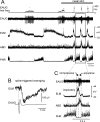Multifunctional laryngeal premotor neurons: their activities during breathing, coughing, sneezing, and swallowing
- PMID: 17494701
- PMCID: PMC6672375
- DOI: 10.1523/JNEUROSCI.0001-07.2007
Multifunctional laryngeal premotor neurons: their activities during breathing, coughing, sneezing, and swallowing
Abstract
To examine whether motor commands of two or more distinct laryngeal motor patterns converge onto a common premotor network, we conducted dual recordings from the laryngeal adductor motoneuron and its premotor neuron within the brainstem respiratory circuitry during fictive breathing, coughing, sneezing, and swallowing in decerebrate paralyzed cats. Expiratory neurons with an augmenting firing pattern (EAUG), whose action potentials evoked monosynaptic IPSPs in the adductor motoneurons, sharply fired during the expulsive phases of fictive coughing and sneezing, during which the adductor motoneurons transiently repolarized. In contrast, these premotor neurons were silent during the swallow-related hyperpolarization in adductor motoneurons. These results show that one class of medullary respiratory neuron, EAUG, is multifunctional and shared among the central pattern generators (CPGs) for breathing, coughing, and sneezing. In addition, although the CPGs underlying these three behaviors and the swallowing CPG do overlap, EAUG neurons are not part of the swallowing CPG and, in contrast to the other three behaviors, are not a source of inhibitory input to adductor motoneurons during swallowing.
Figures



Similar articles
-
Synaptic origin of the respiratory-modulated activity of laryngeal motoneurons.Neuroscience. 2006 Jul 7;140(3):1079-88. doi: 10.1016/j.neuroscience.2006.02.063. Epub 2006 May 2. Neuroscience. 2006. PMID: 16650611
-
Activity of respiratory laryngeal motoneurons during fictive coughing and swallowing.Exp Brain Res. 2000 Jan;130(1):27-34. doi: 10.1007/s002210050003. Exp Brain Res. 2000. PMID: 10638438
-
Swallow-related inhibition in laryngeal motoneurons.Neurosci Res. 2010 Aug;67(4):327-33. doi: 10.1016/j.neures.2010.04.011. Epub 2010 Apr 29. Neurosci Res. 2010. PMID: 20434496
-
Brainstem respiratory networks and cough.Pulm Pharmacol. 1996 Oct-Dec;9(5-6):343-7. doi: 10.1006/pulp.1996.0045. Pulm Pharmacol. 1996. PMID: 9232673 Review.
-
Activation of XII motoneurons and premotor neurons during various oropharyngeal behaviors.Respir Physiol Neurobiol. 2005 Jul 28;147(2-3):159-76. doi: 10.1016/j.resp.2005.03.015. Respir Physiol Neurobiol. 2005. PMID: 15919245 Review.
Cited by
-
The Potential Role of Oxidative Stress in Modulating Airway Defensive Reflexes.Antioxidants (Basel). 2025 May 9;14(5):568. doi: 10.3390/antiox14050568. Antioxidants (Basel). 2025. PMID: 40427451 Free PMC article. Review.
-
Otolaryngology head and neck surgery: an integrative view of the larynx.Head Neck. 2011 Oct;33 Suppl 1(0 1):S46-53. doi: 10.1002/hed.21901. Epub 2011 Sep 9. Head Neck. 2011. PMID: 21910154 Free PMC article.
-
Laryngeal and tracheal afferent nerve stimulation evokes swallowing in anaesthetized guinea pigs.J Physiol. 2013 Sep 15;591(18):4667-79. doi: 10.1113/jphysiol.2013.256024. Epub 2013 Jul 15. J Physiol. 2013. PMID: 23858010 Free PMC article.
-
Pontine mechanisms of respiratory control.Compr Physiol. 2012 Oct;2(4):2443-69. doi: 10.1002/cphy.c100015. Compr Physiol. 2012. PMID: 23720253 Free PMC article. Review.
-
Ponto-medullary nuclei involved in the generation of sequential pharyngeal swallowing and concomitant protective laryngeal adduction in situ.J Physiol. 2014 Jun 15;592(12):2605-23. doi: 10.1113/jphysiol.2014.272468. Epub 2014 Mar 17. J Physiol. 2014. PMID: 24639482 Free PMC article.
References
-
- Barillot JC, Grélot L, Reddad S, Bianchi AL. Discharge patterns of laryngeal motoneurones in the cat: an intracellular study. Brain Res. 1990;509:99–106. - PubMed
-
- Bartlett DJ. Upper airway motor systems. In: Cherniack NS, Widdicombe JG, editors. Handbook of physiology, Sec 3, The respiratory system. Vol 2. Bethesda, MD: The American Physiological Society; 1986. pp. 223–245.
-
- Batsel HL, Lines AJ. Neural mechanisms of sneeze. Am J Physiol. 1975;229:770–776. - PubMed
-
- Batsel HL, Lines AJ. Discharge of respiratory neurons in sneezes resulting from ethmoidal nerve stimulation. Exp Neurol. 1978;58:410–424. - PubMed
Publication types
MeSH terms
LinkOut - more resources
Full Text Sources
Miscellaneous
